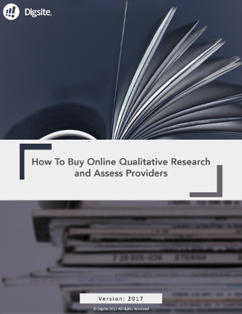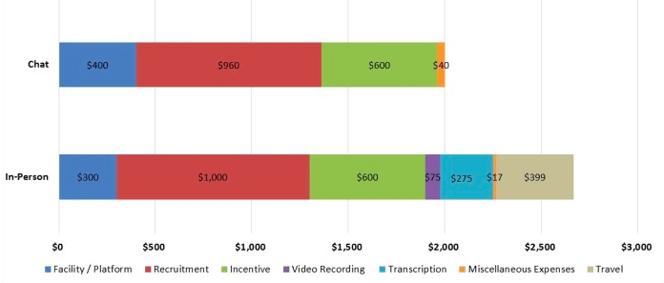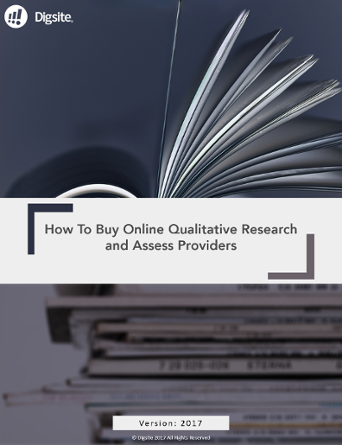The more accurate and actionable insights your team has, the better your decisions will be. Getting high-quality research results starts with picking the right qualitative technology. In this post, we'll explore the five critical factors you need to consider when assessing online qualitative platform providers and how to maximize the chances you’ll pick the right one.
Key points:
- Ensure your qualitative platform provides recruiting with both accurate screening and an engaged audience that can answer in-depth questions
- Look for platforms with the capability for flexible iterations to dig deeper and discover new ideas
- Consider both the platform and available services that make gathering data and analyzing results easy
- Evalute the flexiblity of the technology for short vs. long-term engagements that can help you make a small budget go a long way
- Partner with a company that moves as quickly as you do will ensure you meet deadlines and make the right decisions
In the past, there were few choices for a qualitative research platform. For the most part, companies that needed to gather data would reach out to a consultant who would conduct in-person or online focus groups to get the information they needed—and potentially outsource their technology needs. Not only was this a time-consuming and expensive process, it also didn’t produce the best results, as consultants were often biased toward more time consuming and expensive processes. Online methods often reduce social desirability bias of in-person methods, as participants would rather tell a researcher something we think they’d like to hear in order to be liked—instead of how we actually feel.
Now, thanks to the evolution of technology and the emergence of advanced digital qualitative solutions, there are more research options available than ever before. This gives companies the opportunity to leverage consultants when they are needed, but to have more rapid access to online methods that save both time and money.
But how exactly can an organization figure out which research platforms makes the most sense for their specific situation?
First things first: You need to evaluate your objectives and decide which kind of online research method fits your goals the best. For example, if you’re looking to identify opportunities and rapidly iterate, iterative insights communities probably makes the most sense. If, on the other hand, you’re looking to have real-time one-on-one interviews with your target audience, a video interview platform might be a better approach.
If you'd like to learn more about the variety of online qualitative methods that are available to you, a fully expanded guide is availabe in our complimentary whitepaper below.

[Download: How to Buy Online Qualitative Research and Assess Providers]
Once you’ve determined which online method makes the most sense for your purposes, it’s time to figure out which research platform to work with. Generally speaking, there are five major factors to consider while searching for the right platform provider.
1. Sample Quality
We've all probably experienced the focus group where you discover one or more of the participants don't actually fit into your target audience. Lets face it, if your research sample isn’t high-quality to begin with, the results you obtain won’t be any good either. With that being the case, it is critical to do some digging into the kind of sample that research platforms offer.
Many online research companies are built using national survey panels to find qualitative participants. In my experience, when trying to recruit these people for qualitative studies, as many as 50% are either not who they say they are or aren't articulate enough to engage in an online conversation. Traditional Focus Group facilities have better success finding qualified and articulate participants, but typically at a cost of $100 per person or more.
Social media is changing the dynamic of quality qualitative recruiting. Digsite, for example, uses a proprietary tool called SocialFind℠ that micro-targets participants on social media sites like Facebook, Instagram or Linked-In. This approach only allows people with demonstrated demographics, interests or behaviors to be invited, and their presence on these social media sites ensures that customers are comfortable interacting in an online environment.
Do your due diligence to determine how various research providers ensure quality participants.
2. Actionable Insights
You’ll also need to determine whether the research provider you’re considering helps you get to the decision you need to make. Some qualitative methods give you open ended responses, but others give you the flexibility to iterate as as you learn so you can probe or explore further. Ask yourself whether you need the opportunity to engage with the participants and expand or change your questions as you learn, or even show them new ideas as they tell you about their needs. If you’re not able to ask follow-up questions, the data you collect will represent initial thoughts or behaviors—which may or may not be enough to help you determine the best solution.
Iterative Insights communities, for example, enable participants to interact with one another on a social media-style “wall”. As participants communicate with each other, new ideas or experiences might emerge that weren't initially shared. Partner with a research provider that allows you to follow conversations like these to make better decisions and enjoy better results.
3. Service Level
As you narrow down your options, it’s important to consider how much work each platform will require from you or your team. Can you set everything up easily yourself, or does it require IT support or full-service moderation? Do they have experts to help you design activities, moderate or analyze results when you need them? Do you have to use several tools( email, instant messaging and other platforms) to conduct research, or is everything on the same platform?
You’re looking for a platform that will make gathering data as easy as possible for you. Look for providers that actually value your time. Best-in-class providers offer self-service features, automation and support (when needed)—in other words, superior service.
4. Budget
You might find the best research provider in the world - but if that company prices their services at a price point you can’t afford, you’ll have to move on to the next-best option.
Even if you have more money in your budget than you know what to do with, odds are you still want to get the most bang for your buck. The more money you can save on research—without compromising on the quality of your findings—the better.
If money is a concern—and really, it always should be—you’re likely to find that online qualitative research makes the most sense for your needs. Quite simply, because of the cost savings that come from technology, online qualitative can make a small budget go a long way.
For example, in-person research generally costs an average of $500–$1,000 per person to conduct, while online qualitative is often half that. Further, the overall cost of in person research is significantly higher than online:

What’s more, the best research providers tend to offer long-term subscriptions that save you even more time and money by streamlining your approach further.
5. Speed and Agility
One of the biggest problems about research today is that many organizations simply don’t act upon it. One of the causes of this unfortunate trend is the fact that research is often not provided in a timely manner (or, on the flipside, tight corporate deadlines push product releases out before they’re ready).
To get the best results, you need to partner with research providers that move quickly. This is one of the reasons why online qualitative research is becoming increasingly popular. Companies that use online qualitative research get results quickly. In fact, newer tools like Digsite can often launch a community the same day, with initial results overnight. This enables companies to iterate rapidly and move with agility, responding to shifts in customer sentiment right away.
The last thing your company wants to do is forgo research because of timing and make the wrong decisions. Not only can poor decision-making cost a lot of money, it can also alienate customers.
By partnering with a provider that enables you to conduct research quickly, adjust questions as you go and interact directly with participants, you increase the chances that the data you collect is helpful and actionable. Armed with that information, you’re much likelier to make the right decisions.
Because qualitative data is so integral to the success of your company, your decision about which research provider to partner with is one you shouldn’t take lightly.
The faster you’re able to collect and gather high-quality data, the more agile your company will be. Partner with the right research provider so you’ll get the right data—quickly and inexpensively. That’s the ticket to exceeding your customers’ expectations—time and again.
To learn more about How To Buy Online Qualitative Research and Assess Providers, check out our whitepaper!





